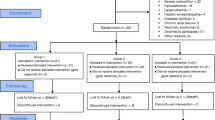Abstract
Objective
To compare the incidence of hyponatremia during the first 48 h in hospitalized children receiving normal saline vs. N/2 saline as maintenance intravenous fluid.
Methods
This open label, randomized controlled trial to compare the incidence of hyponatremia in hospitalized children receiving normal saline (0.9% sodium chloride in 5% dextrose) vs. N/2 saline (0.45% sodium chloride in 5% dextrose) as maintenance fluid was conducted from December 2014 through November 2015 in a tertiary care teaching hospital. Children between 1 mo and 18 y requiring maintenance intravenous fluids were randomized to receive normal saline with 5% dextrose (n = 75) or N/2 saline with 5% dextrose (n = 75).
Results
Both groups were comparable for demographic variables and illness severity at baseline. Incidence of hyponatremia at 24 h of hospitalization was comparable between normal saline and N/2 saline group, 3(4%) vs. 6(8%) cases, respectively; p value 0.494. Mean serum sodium levels were marginally higher in normal saline group (138.3 ± 6.0 mEq/L) as compared with N/2 saline group (135.1 ± 4.4 mEq/L) (p value <0.01) at 24 h of hospitalization. Incidence of hyponatremia at 48 h and hypernatremia at 24 and 48 h was comparable in two groups.
Conclusions
The use of either N/2 saline or normal saline in sick children at standard maintenance fluid rates is associated with low but comparable incidence of hypo or hypernatremia in first 24 h of hospitalization. Both types of fluids appear acceptable in hospitalized sick children.

Similar content being viewed by others
References
Holliday MA, Segar WE, Friedman A, Chesney R, Finberg L. Intravenous fluids for seriously ill children. Lancet. 2004;363:241.
Foster BA, Tom D, Hill V. Hypotonic versus isotonic fluids in hospitalized children: a systematic review and meta-analysis. J Pediatr. 2014;165:163–9.
Wang J, Xu E, Xiao Y. Isotonic versus hypotonic maintenance IV fluids in hospitalized children: a meta-analysis. Pediatrics. 2014;133:105–13.
Arieff AI, Ayus JC, Fraser CL. Hyponatraemia and death or permanent brain damage in healthy children. BMJ. 1992;304:1218–22.
Bohn D. Children are another group at risk of hyponatraemia peri-operatively. BMJ. 1999;319:1269.
Armour A. Dilutional hyponatraemia: a cause of massive fatal intra-operative cerebral edema in a child undergoing renal transplantation. J Clin Pathol. 1997;50:444–6.
Halberthal M, Halperin ML, Bohn D. Lesson of the week: acute hyponatraemia in children admitted to hospital: retrospective analysis of factors contributing to its development and resolution. BMJ. 2001;322:780–2.
Moritz ML, Ayus JC. Hospital-acquired hyponatraemia–why are hypotonic parenteral fluids still being used? Nat Clin Pract Nephrol. 2007;3:374–82.
Rey C, Los-Arcos M, Hernandez A, Sanchez A, Diazz JJ, Lopez-Herce J. Hypotonic versus isotonic maintenance fluids in critically ill children: a multicenter prospective randomized study. Acta Paediatr. 2011;100:1138–43.
Shann F, Pearson G, Slater A, Wilkinson K. Paediatric index of mortality (PIM): a mortality prediction model for children in intensive care. Intensive Care Med. 1997;23:201–7.
Chow E, Fox N, Gama R. Effect of low serum total protein on sodium and potassium measurement by ion-selective electrodes in critically ill patients. Br J Biomed Sci. 2008;65:128–31.
Kim H, Kim JK, Cho SC. Comparison of sodium ion levels between an arterial blood gas analyzer and an autoanalyzer in preterm infants admitted to the neonatal intensive care unit: a retrospective study. BMC Pediatr. 2016;16:101.
Wilkinson E, Rieff J, Rekate H, Beals S. Fluid, blood, and blood product management in the craniofacial patient. Pediatr Neurosurg. 1992;18:48–52.
Hoorn EJ, Geary D, Robb M, Halperin ML, Bohn D. Acute hyponatraemia related to intravenous fluid administration in hospitalized children: an observational study. Pediatrics. 2004;113:1279–84.
Brazel PW, McPhee IB. Inappropriate secretion of antidiuretic hormone in postoperative scoliosis patients: the role of fluid management. Spine. 1996;21:724–7.
Choong K, Kho M, Menon K, Bohn D. Hypotonic versus isotonic saline in hospitalised children: a systematic review. Arch Dis Child. 2006;91:828–35.
Neville KA, Verge CF, Rosenberg AR, O'Meara MW, Walker JL. Isotonic is better than hypotonic saline for intravenous rehydration of children with gastroenteritis: a prospective randomised study. Arch Dis Child. 2006;91:226–32.
Armon K, Riordan A, Playfor S, Millman G, Khader A, Society PR. Hyponatraemia and hypokalaemia during intravenous fluid administration. Arch Dis Child. 2008;93:285–7.
Duke T, Mokela D, Frank D, et al. Management of meningitis in children with oral fluid restriction or intravenous fluid at maintenance volumes: a randomized trial. Ann Trop Pediatr. 2002;22:145–57.
Hoorn EJ, Geary D, Robb M, Halperin ML, Bohn D. Acute hyponatraemia related to intravenous fluid administration in hospitalized children: an observational study. Pediatrics. 2004;113:1279–84.
Kannan L, Lodha R, Vivekanandhan S, Bagga A, Kabra SK, Kabra M. Intravenous fluid regimen and hyponatraemia among children: a randomized controlled trial. Pediatr Nephrol. 2010;25:2303–9.
Shamim K, Afzal K, Ali SM. Safety and efficacy of isotonic (0.9%) vs. hypotonic (0.18%) saline as maintenance intravenous fluids in children: a randomized controlled trial. Indian Pediatr. 2014;51:969–74.
McNab S, Ware RS, Neville KA, et al. Isotonic versus hypotonic solutions for maintenance intravenous fluid administration in children. Cochrane Database Syst Rev. 2014;Issue12:Art. No. CD009457.
Feld LG, Neuspiel DR, Foster BA, et al; Subcommittee on fluid and electrolyte therapy. Clinical practice guideline: maintenance intravenous fluids in children. Pediatrics. 2018;142:e20183083.
Author information
Authors and Affiliations
Contributions
NKB: Designing the study, monitoring the data collection, interpretation of data and drafting the manuscript; VKS: Data collection and analysis and drafting the manuscript; SB: Analysis of data and drafting the manuscript; AK: Conception and design of the work, drafting and revising the work for important intellectual content. All authors approved the final version of draft. AK is the guarantor for this paper.
Corresponding author
Ethics declarations
Conflict of Interest
None.
Additional information
Publisher’s Note
Springer Nature remains neutral with regard to jurisdictional claims in published maps and institutional affiliations.
Rights and permissions
About this article
Cite this article
Bagri, N.K., Saurabh, V.K., Basu, S. et al. Isotonic versus Hypotonic Intravenous Maintenance Fluids in Children: A Randomized Controlled Trial. Indian J Pediatr 86, 1011–1016 (2019). https://doi.org/10.1007/s12098-019-03011-5
Received:
Accepted:
Published:
Issue Date:
DOI: https://doi.org/10.1007/s12098-019-03011-5




